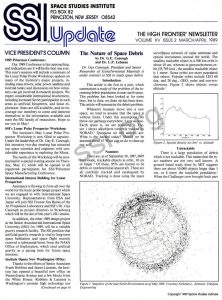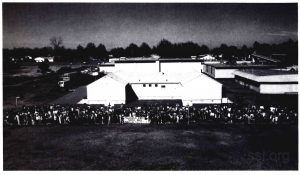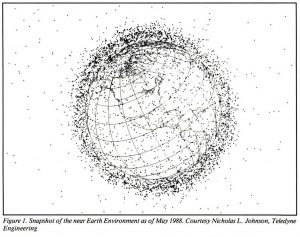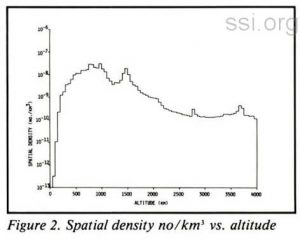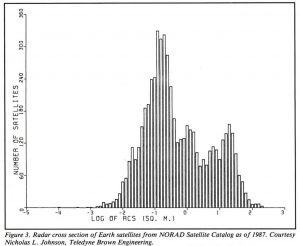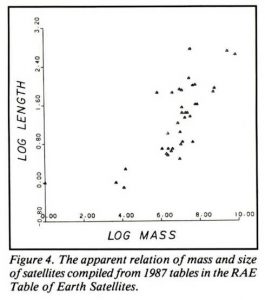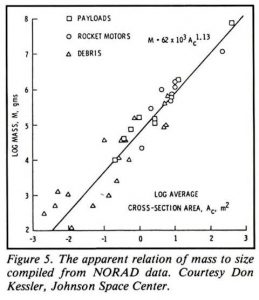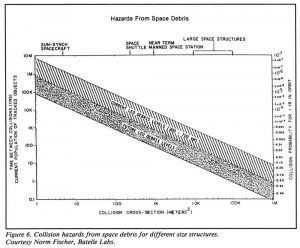SPACE STUDIES INSTITUTE
P.O. BOX 82
PRINCETON, NEW JERSEY 08542
[[librarian note: This address is here, as it was in the original printed newsletter, for historical reasons. It is no longer the physical address of SSI. For contributions, please see this page]]
SSI UPDATE
THE HIGH FRONTIER® NEWSLETTER
VOLUME XV ISSUE 2 MARCH/APRIL 1989
VICE PRESIDENT’S COLUMN
1989 Princeton Conference:
Our 1989 Conference is fast approaching, and indications are it will be the best one ever. This year’s sessions will include a summary of the Lunar Polar Probe Workshop; updates on many of the Institute’s major projects, including mass drivers, solar power satellites and external tanks; and discussions on how volunteers can get involved in research projects. We expect considerable international involvement, including increased Soviet participation in such areas as artificial biospheres, and lunar exploration. Seats are still available, and we encourage our members to come and immerse themselves in the information available and meet the SSI family of researchers. Hope to see you in May!
SSI’s Lunar Polar Prospector Workshop:
The Institute’s May Lunar Polar Prospector Workshop is now filled to capacity. Under the leadership of Dr. Gay E. Canough, this intensive two-day meeting has attracted top space scientists and engineers with considerable experience in exploring the Moon.
The results of the Workshop will be summarized in a special evening session on Thursday, May 11, which will be opened to all registered participants for SSI/Princeton Space Manufacturing Conference.
International Interest Building for Lunar Prospector:
Assistance is flowing in from all over the world for the lunar probe design project which we are engaged in with International Space University. Representatives from ESA and Japan will join SSI Trustee Jim Burke of the Jet Propulsion Laboratory and SSI’s Dr. Gay Canough as project directors in Strasbourg which will be the site of this year’s ISU session.
In addition, the other 1989 design project at the Senior Associate-led International Space University (ISU) for 1989, will be a variable gravity research facility. The SSI position that artificial gravity research is vital to long-term space habitation and space flight recently received a substantial boost from the NASA Office of Exploration, which cited artificial gravity as a pacing item for future space missions.
Institute Opens New Washington Office:
Thanks to the efforts of Senior Associates Frank Robbins and James Laramie, the Institute has opened a beautiful new office on Pennsylvania A venue just a few blocks from the White House. Robbins & Laramie is Washington’s premier high technology law firm with a worldwide clientele in aerospace, biotech and other chemical industries. We are grateful to Mssrs. Robbins and Laramie for their most generous donation of this office space. Thanks to their help and that of an anonymous donor, we now have a beautiful facility in a prestigious location, which we will use for fund-raising, education and public relations. In particular, having a place to meet with key Washington decision-makers will enhance our ability to present the SSI alternative to the traditional “flags and footprints” space program.
Soviet Update:
As mentioned in the last issue of our newsletter, SSI has completed a pair of agreements with the Moscow Aviation Institute (MAI) to begin collaboration on joint space projects. In addition to a general declaration of intent, we agreed upon a series of step-by-step milestones to identify projects of joint interest. Projects currently under discussion include probes to determine the chemicals available on the lunar surface; variable gravity research experiments, including precursors to eventual manned facilities and a space power test demonstration for International Space Year in 1992, which would involve the transmission of electrical power from one spacecraft to another.
In the past month SSI inaugurated an electronic mail connection to the Moscow Aviation Institute and other Soviet scientific establishments via the San Francisco/Moscow Teleport. Using this new electronic link, we have received abstracts from professors at MAI for our May Conference and we look forward to having them join us in Princeton.
Our Soviet colleagues were excellent hosts during my week-long trip in December. Our team was admitted to places never before seen by Westerners and were also treated to a visit to the Kaliningrad Flight Control Facility, which handles both manned operations such as Mir and the Soviet space shuttle, and deep space missions such as the Phobos probes. In fact, we were permitted on the floor of the control room for the new Soviet shuttle and were allowed to take pictures of consoles, computer displays, etc. In general, we were pleasantly surprised at the openness of the discussions and sense a strong desire on the part of our colleagues for substantive collaboration.
Japanese SPS and Lunar Interest:
Both government and industries in Japan are showing keen interest in space resource utilization, and in particular, the solar power satellite concept. The new brochure of NASDA (the National Space Development Agency of Japan) in its discussion of economic and social contributions of space, says: “(U)ntapped resources and energy in space open many possibilities for use by mankind.” The corporate brochure of Mitsubishi Electric Corporation features a solar power satellite in its discussion of major future programs. Shimizu Corporation, one of the largest construction companies in the world, has instituted a space program office with interest in solar power satellites and lunar bases. Their newest brochure shows a lunar base complete with a mass driver sending raw materials into space for construction of solar power satellites.
SSI to Sponsor International Space Power Conference:
SSI will cosponsor the International Astronautical Federation Conference on Space Power on June 5-7, 1989, in Cleveland, Ohio. We will present a paper on the use of nonterrestrial materials for solar power satellite construction, and we encourage SSI members with an interest in space solar power to attend. To get on the mailing list for conference brochures, contact Kathy Williams at SSI Headquarters.
How Big is an ET?:
Students of the Hilldale Elementary School in Muskogee, Oklahoma would be happy to tell you. They chalked out an outline of the hydrogen and oxygen tanks of the space shuttle next to their school, and 740 of them stood on the resulting footprint. Congratulations to the students and their teachers for an innovative demonstration of the size of this space resource.
This issue of Update features a preliminary report on the space debris problem. Space debris falls squarely on our critical path for three reasons. As you will see, the debris problem is such that it may pose a significant barrier to space operations if left unchecked. However, cleaning up the debris problem may actually generate a form of nonterrestrial resources with commercial viability in limited cases. In addition, it appears that some of the best ways to resolve the problem involve the application of nonterrestrial materials, and so, resolving the problem may lead to a market to assist in the human breakout into space.
Downrange:
The next newsletter will feature an SSI project status report. Until then, best regards,
Gregg Maryniak
The Nature of Space Debris
by Dr. G.E. Canough and Dr. L.P. Lehman
Dr. Gay Canough, President and Senior Researcher of ExtraTerrestrial Materials is under contract to SSI to study space debris.
Introduction
This article is the first in a pair, which summarizes a study of the problem of the increasing debris population in near earth space. This problem has been looked at for some time, but to date, no clean up has been done. This article will summarize the debris problem.
Whenever humans move into a new space, we tend to assume that the space is without limits. Under this assumption, we throw our garbarge everywhere. Large as nearEarth space is, we are polluting it. Figure 1 shows all objects currently tracked by NORAD.[3] Questions we will address are: What is the hazard today? Should we be alarmed about it? What can we do to clean up our act?
Numbers
There are, as of September 30, 1987, 6895 man-made, trackable objects in orbit, 10 cm or larger.[8] Of these, 95% are known to be debris or nonfunctional spacecraft. These are all carefully tracked and catalogued by NORAD. Tracking is done using the space surveillance network of radar antennae and optical instruments around the world. The smallest trackable object in a 500 km orbit is about 10 cm, whereas in geosynchronous orbit (35,785 km), the smallest trackable object is 1 meter. Some orbits are more populated that others. Popular orbits include LEO 60 deg. and 28 deg., GEO, polar and sun-synchronous. Figure 2 shows objects versus altitude.[3]
There is a large population of debris which is not trackable. This means that the exact numbers are not very well known. A ground based study done by MIT suggests there are about 50,000 objects larger than 1 cm, or 8 times the trackable population.[4] When the Challenger crew brought back part of the Solar Max satellite’s shields, 60% of the pock marks and holes in it were caused by man-made debris.
Sizes
The sizes of objects are not very well known. There are two ways to learn the size. First, for intact satellites, one can ask the owner how large it is and second, NORAD radar can give an estimate based on the objects’ radar cross section. Figure 3 shows a size distribution from radar and Figure 4 shows a size distribution based on data from The RAE Table of Earth Satellites. Untrackables range from microns to a few centimeters in size. Figure 5 shows derived masses. Note that it is impractical to shield satellites against collisions with anything larger than 100 grams, i.e. about 2 mm in diameter. Early satellites were quite small, (a few hundred pounds), whereas satellites of today are several thousand pounds.
The main source of debris is man-made. Large pieces include:
• Inactive satellites
• Used rocket motors and bodies
• Payload fairings which are ejected for every item launched
• Used nuclear fuel assemblies (1.5 tonnes worth!) from Russian reactors.
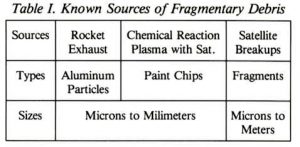
Smaller debris is of several classes, as summarized in Table I. There are paint chips from spacecraft bodies and aluminum particles from rocket exhaust. All we know about these is that they exist and can cause damage, as shown by the 1/8″ crater in the STS-7 orbiter window (caused by collision with a 0.2 mm paint chip).
The data for trackable objects still in orbit as of January 1987, which resulted from satellite breakups, is shown in Table II.
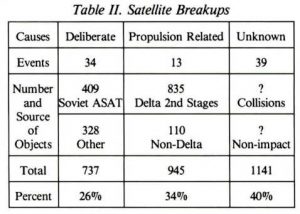
Of the propulsion related breakups, Delta upper stages account for most of the propulsion related debris still in orbit.
For deliberate breakups, 55% of the debris still in orbit can be accounted for from Soviet ASAT tests. The US has conducted 1 SDI test so far which made debris.
An Ariane rocket which blew up in 1986 added 200 pieces of debris, strewn from 430 km to 1350 km in altitude.[1] Cosmos 1275 is suspected to have collided with other debris. The particularly messy fragmentation of 10 satellites is said to account for 1/3 of all trackable debris.[3]
Sinks
There are also some sinks which eliminate debris. These are drag from the atmosphere (for low orbits) and drag from solar radiation. Atmospheric drag is very effective for eliminating small pieces such as paint chips. These fall back to Earth in periods on the scale of weeks. Even larger items will come down due to drag, for example, Skylab. The time it takes depends on the orbit and (less strongly) on the cross section of the object. For example, a satellite in a 100 mile orbit will be dragged down in just 2 days, whereas a satellite in GEO will stay up for several thousand years.[9]
The Hazard of Debris
Things like explosions will produce debris which may cross the original orbit, or be moved to higher or lower orbits. For example, the breakup of satellite 1975-04B had an apogee of about 900 km and a perigee of about 700 km. One of its fragments had an apogee of about 1400 km. Also, various orbital perturbations act on all satellites, causing their paths to vary slowly with time. Typical collision velocities in LEO are about 10 km/sec, so bumping into even small things is a deadly serious matter.
Anyone planning a large structure in low orbit needs to know the probability that the structure will be damaged by collision with space debris over a certain period of time. Collision hazard is usually expressed as a function of the cross sectional area presented by the structure and the time span of exposure, i.e. as “impacts / (meter2 * year).” Calculations of collision hazard depend on the creation of a spatial density model (number of objects per unit volume of space) for all debris objects. The specific formulation of spatial density models differs slightly for different types of hazard calculations; however, all are based on the data taken from the NORAD data base with estimated corrections for the effects of orbital perturbations and drag.
It is worth restating for the record the large uncertainties involved in all hazard calculations. A large number of potentially lethal objects are simply not detected by the NORAD. The correction factor for undetected debris is found to be 5 to 10 times the detected orbital population for low to medium Earth orbits. Other uncertainties arise from the variability of drag with altitude and solar activity. Also, radar measurements tell us almost nothing of the composition of fragments and may be quite inaccurate about fragment size due to odd shapes or orientations of fragments. However, it is worth noting that the predictions of these hazard calculations has always fallen short of the actual hazard levels when it has been possible to measure it.
Figure 6 shows a typical result of a collision hazard calculation based solely on the objects tracked by NORAD, i.e. 10 cm or larger. Larger structures have proportionately greater risk of collision than do smaller objects, and the collision hazard tends to increase with time. For example, a simple hazard calculation for the NASA space station indicates an approximate 10% chance that it will collide disastrously with man-made debris within its ten year life. Ironically, the chance of a colliion with a similar sized meteor is 4 orders of magnitude less!
GEO Hazards
Perhaps the most delicate and vulnerable spot in near-Earth space is at geosynchronous orbit (35785 km above sea level with an inclination of less than 5 degrees). At this distance from Earth, all satellites have a period of 1 day and so appear to hover over one spot on the equator. This is therefore the ideal orbit for communications satellites. Currently the NORAD Space Surveillance Network tracks approximately 300 objects, 1 meter in diameter or larger, in near geostationary orbits. An additional 2000 nontrackable objects are also believed to inhabit this region of space.
The environment of geostationary orbit is quite different from that of low-Earth orbit. In LEO, drag is often the dominate mode of orbital perturbation, causing many small pieces of debris to decay from orbit in a few days to, at most, a few decades. In GEO there are three main contributions to orbital perturbations. 1) Atmospheric drag is the least significant factor effecting objects in geostationary orbit. In GEO, debris will lose approximately 1km of altitude in 1,000 years due to drag. 2) The oblateness of the Earth causes a slow drift of objects in GEO to the vicinity of the two libration points, (105 West longitude and 75 East longitude). 3) The Sun and Moon cause a slow inclining of the orbits to a maximum of about 15 degrees. This last effect is the most significant. It requires 66% of a GEO satellite’s fuel reserves over its lifetime (10 yrs) to correct for the slow inclining of its orbit. 10 Debris objects do not use station keeping fuel and thus obtain orbital inclinations of about 10 degrees. Seen from the equator such objects travel North-South paths in figure eight patterns, ranging 8,000 to 10,000 km north and south of the ideal geostationary orbit. Each such object passes through the geostationary orbit ring twice each day at its maximum relative velocity of a few hundred meters per second.
The geostationary orbital ring is approximately 265,000 km long. If we only consider the 300 trackable objects in this region, we come up with an average separation of approximately 900 km. The current probability of a collision anywhere in GEO is on the order of 0.005% per year. However, by the year 2000 (only 12 years from today!) this probability is expected to increase to approximately 5% per year. Even a single fairly moderate collision can be expected to generate tens of thousands of fragments. And because the orbit is so high, if there is even one fragmentation of a satellite in GEO, the pieces will stay up there for thousands of years, passing through the ring twice daily.
A more immediate problem for GEO satellite operators is that tracking of objects in GEO (that are not transmitting) is only accurate to kilometers. That is, when something passes to within a few kilometers, the operator must expend station keeping fuel to make certain no collision occurs. More junk means more fuel, which translates into a higher operating cost.
Conclusions
While debris is not causing major disasters today, it is growing at a poorly defined rate.
The amount of debris in orbit already is not very well known. Radar can only detect objects 10 cm and larger, but a 1 cm object can wreck working satellites.
There is some threshold at which the amount of debris will multiply of its own accord, through collision. We do not know when this threshold will be met.
It is nearly impossible to remove the smaller debris by some man-made means. We can only wait for it to be dragged down. This implies that, even if we launch nothing more as of today, the debris cloud already in place will persist for decades.
More countries are launching things now, and although the yearly launch rates have been nearly constant for the last 20 years, we expect this will change. In the past the US and USSR were the only players. Now there is ESA, Japan, China and all the private launchers.
Orbital space will get dirtier.
Action should be taken now in the form of International agreements and policies. Agreements on ASA T and SDI testing should also be made. Finally, just like on Earth, we need a garbage collection service. Although the easiest solution to debris is not to create it, old habits are hard to break. The large pieces of debris and dead satellites could be collected and de-orbitted or salvaged, thus removing the source of future debris fragments. We will explore some of the problems and solutions for debris collection in part 2 of this paper.
(Part 2 will appear in an upcoming issue of Update.)
Acknowledgements:
We thank Nicholas Johnson of Teledyne Brown for friendly discussions on charts and graphs presented in his excellent book, “Artificial Space Debris.”
We thank Don Kessler for sending us his collection of articles and getting us started on understanding space debris.
We thank the Space Studies Institute for supporting this work.
1) Debris Threat Poses Future Hazard, R.D. Lorenz, Space flight, Vol. 30, No. 1, p4, Jan 1988
2) Orbital Debris Environment and Spacecraft Shielding, A collection of articles by Don Kessler and Burton Cour-Palais, Johnson Spaceflight Center, SN3, Houston, TX 77078
3) Artificial Space Debris, N. Johnson and D. McKnight, Orbit Books,Malabar, FL (1987)
4) Satellite Debris: Recent Measurements, L.G. Taff, MIT, J Spacecraft, v23, p342 (1985)
5) Debris Danger Zone, D. Kessler, Johnson Space Center, Natural History, 11/87
6) Curbing Pollution in Space, J.D. Scherega, Technology Review, Jan 1986
7) Cleaning up our Space Act, B. Frisch, Aerospace America, Feb 1987
8) Satellite Situation Report, NASA, Goddard Space Flight Center, Vol 27, no. 3 Sept. 30, 1987
9) Fundamentals of Astrodynamics, R. Bate, D. Mueller, J. White, Dover Books, 1971
10) Introduction to Satellite Communication, B. Elbert, Artech House Publishers, 1987
11) The RAE Table of Earth Satellites, Compiled by the Royal Aircraft Establishment, Farnborough, England
The 9th Biennial SSI/Princeton Conference on Space Manufacturing
May 10 – 13, 1989
GENERAL INFORMATION
The 9th Biennial SSI/Princeton Conference on Space Manufacturing is a forum for papers on all aspects of the use of nonterrestrial resources. The program includes papers both on technical aspects of space development and on the social sciences.
In order to accomodate a broad range of presentations, different types of presentation will be encouraged: 1) the traditional presentation of papers in the auditorium at the Woodrow Wilson School, 2) a poster session and display.
The first three days of the Conference will be open only to registered participants. A summary session on Saturday, May 13 is free and open to all.
CONFERENCE REGETRATION
A registration fee of $290 includes lunches, coffee breaks, the Friday night banquet and a copy of the published proceedings. Registration is through the Space Studies Institute. Barbara Faughnan, Conference Coordinator, is available weekdays to answer any questions you may have, or to handle your registration by phone xxx-xxx-xxxx.
HOTEL ACCOMODATIONS
The Ramada Inn has been selected as our Conference Headquarters. It is located approximately three miles north of Princeton on Route 1. The Inn will provide bus service to and from the University’s Woodrow Wilson School as parking spaces in town and on campus are severely limited. Upon receipt of the Conference registration fee, a hotel reservation card will be mailed to you; or you may make reservations directly by phone at xxx-xxx-xxxx.
CONFERENCE PROGRAM
Following is a listing of sessions, chairmen, and a partial list of participants and sponsors:
Woodrow Wilson School,
Princeton University
Wednesday, May 10
Registration
Keynote Address:
Frank Martin, Office of Exploration
NASA Headquarters
Welcoming Remarks: Congressman Torracelli
Session I: EXTERNAL TANKS
Chair: Faye Bailiff and Thomas Mobley
Martin Marietta
“The OUTPOST Concept, A Commercial Space Platform Opportunity”
Thomas C. Taylor
Global Outpost, Inc.
“Preflight Modification and On-orbit Assembly Configurations to Enhance Orbital Utilization of Space Shuttle External Tanks”
Robert L. Price
Martin Marietta
“Evaluation of Aerodynamic Drag and Torque in Low Earth Orbit”
William C. Stone and Christoph Witzgall
National Institute of Standards and Technology
“Commercial Development of Space Shuttle External Tanks”
Barbara Stone
Officer of Commercial Programs/NASA
“Viewing the Shuttle’s External Fuel Tank as an Orbital Resource”
Ronald D. Jones
Bartlesville, OK
Session II: SPACE BIOSPHERES
Chair: Mark Nelson
Institute of Ecotechnics
“A System for Recycling Organic Materials in a Microgravity Environment”
Judith A. Field and
Nicholaus Leggett
Washington, DC
“Bioregenerative Space and Terrestrial Habitat”
B.C. Wolverton,
R.C. McCaleb, and
W.L. Douglas
NASA-Stennis Space Center
“CELSS Breadboard Project: 1988”
W.M. Knott, J.C. Sager, R.P. Prince, J.D. Jones
NASA Kennedy Space Center
Thursday, May 11
Session III: SPACE MANUFACTURING AND SPACE POWER
Chair: Peter Glaser
Arthur D. Little Company
“Parametric Analyses of Lunar Resources for Space Energy Systems”
Gordon R. Woodcock
Boeing Aerospace Huntsville
“SP-100, A Flexible Technology for Space Power for 10s to 1OOs of KWe”
Philip R. Pluta et al
General Electric
“Beamed Power Transmission and Transportation System in Equatorial Plane”
William C. Brown
Weston, MA
“Preliminary Lunar Teleoperations Investigations Using a Low Cost Mobile Robot”
Robert H. Lewis
Space Studies Institute
“Near-Term Nonterrestrial Materials Usage in Solar Power Satellites”
Brian Tillotson and Paul Dubose
Space Research Associates, Inc.
Session IV: INTERNATIONAL AND ECONOMIC CONSIDERATIONS
Sponsored by the Geostar Corporation
Chair: Irwin Pikus
U.S. Department of Commerce
“New Initiatives in Technology and Enterprise”
Kyle Fairchild
NASA Johnson Space Center
“Entrepreneurial Space Business”
Martin A. Rothblatt
Geostar Corporation
“Funding the High Frontier: Old Lessons We Must Once Again Learn”
James E. Dunstan
Haley, Bader & Potts
“Macro-Projects in Space: The Prospects for International Cooperation in the 1990s” Michael A.G. Michaud
US Department of State
“Commercial Infrastructure Participation in the Space Studies Freedom Program”
Kevin Barquinero
NASA
Session V: NONTERRESTRIAL RESOURCES
Sponsored by Boeing Aerospace
Chair: John Lewis
Lunar and Planetary Laboratory
“The Utility of Imaging Spectrometry in the Detection of Ore Minerals on the Earth, Mars, Moon and Asteroids”
William H. Farrand and Robert B. Singer
University of Arizona
“Physical Economics of Space Resource Utilization”
Andrew Hall Cutler
Minerva Laboratories
“Magnetic Beneficiation of Lunar Soils”
R.R. Oder
EXOPRTech Company
Rudolph Keller
EMEC Consultants
Lawrence A. Taylor
University of Tennessee
“Magma Partial Oxidation: A New Method for Oxygen Recovery From Lunar Soil”
R.D. Waldron
Rockell International
“Oxygen Liquefaction & Storage System for Lunar Oxygen Production Plant”
Eric B. Jenson, B. MacLaren, Gary McMurry and James Brazell
Pacer Works, Ltd.
POSTER SESSION
Sponsored by OMNI Magazine
Chair: James Burke, Jet Propulsion Laboratory
Lunar Polar Probe Workshop Summary Session
Chair: Gay Canough ExtraTerrestrial Materials, Inc.
Friday, May 12
Session VI: SPACE TRANSPORTATION
Sponsored by Arianespace, Inc.
Chair: Ed Bock
General Dynamics
“Ariane Utilization for Secondary Payloads”
Eckard Weinrich
Arianespace, Inc.
“Recent Results from an Enhanced MD-III Simulation”
Les Snively
Space Studies Institute
“Concept For a Lunar The Transporter Using an In-Orbit Modified Shuttle External Tank”
A.J. Buttefield and
J.W. Goslee
NASA – Langley
“The Nature of Space Debris and How to Clean It Up”
Gay Canough and L. P. Lehman
ExtraTerrestrial Materials, Inc.
“How a Nuclear-Oxygen Lunar Shuttle Can Help Us Beat The Fuel Bottleneck in Early Lunar Exploration and Space Build-Up”
Daniel J. Connors
Warner Robins, GA
Session VII: LUNAR BASES
Chair: Wendell Mendell
NASA Johnson Space Center
“A Lunar Propellant Supply System”
Patricia Buddington, Brent Sherwood, and Benjamin Donahue
Boeing Aerospace – Huntsville
“Solar Power for the Lunar Night”
Geoffrey A. Landis
NASA Lewis Research Center
“Robotic Lunar Surface Construction”
Brent Sherwood
Boeing Aerospace – Huntsville
“Evaluation of Lunar Base Structures”
H. Benaroya, M. Ettouney, J. Wright
Weidlinger Associates
“Site Selection for a Lunar Base”
Alice Eichold
Yale University School of Forestry and Environmental Studies
“The International Lunar Initiative: The 1988 Design Project of the International Space University”
Todd Hawley and Peter H. Diamandis
International Space University
Session VIII: BIOMEDICAL CONSIDERATIONS
Chair: James Logan, M.D.
NASA Headquarters
“The Effects of Microgravity on Immune Function”
G.R. Coulter
Jet Propulsion Laboratory
Gerald Taylor
NASA Johnson Space Center
Gerald Sonnelfeld
University of Louisville Medical School
“Artificial Gravity as a Countermeasure in Long-Duration Manned Spaceflight”
James W. Wolfe and Frank M. Sulzman
NASA Headquarters
“Physiological Parameters of Artificial Gravity”
Rex Schultheis, MD
The Johns Hopkins Hospital
“Anesthesia in the High Frontier”
Erik T. Paterson
University of British Columbia
“Multiple Vehicle Low-Orbit Bases Mobile Emergency Trauma Hospital”
Todd Brickhouse
Hygenia Home-Care, Inc.
Ramada Hotel, Princeton, NJ Banquet
Co-sponsored by GE Astro and General Dynamics
Guest Speaker: Robert Cenkar GE Astro
Saturday, May 13
Woodrow Wilson School, Princeton University
Summary Session
Space Studies Institute, Rocky Hill, NJ
Box Lunch Picnic
©space studies institute

